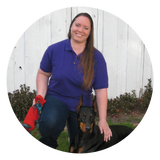Odor is Not Fully Contained in Containers

"WHAT?!”
Blowing your mind right at the outset, huh dear grasshopper?
That’s right, when you are tackling a Container search in Scent Work, the odor is not actually contained within said container.
If it were, your dog would be unable to source it at all. You NEED some odor to be seeping out for your dog to give you that lovely alert you pray for each and every time to step to the line.
What does this mean as far as our expectation for how container searches should be tackled when we are training or trialing? Quite a bit actually.
EXPECTATIONS IN TRAINING
In my opinion, training should be designed to help the dog see as many odor puzzles and pictures as possible and then give them the time and space necessary to solve them. This is what I mean whenever I say “mindful training” or “thoughtful training”.
When it comes to training with containers, the first thing we must do is provide variety. Many of us start by using boxes. Ensure your dog can find hides where the searches are made up of lots of different types of boxes. Big boxes, small boxes, boxes with lids, boxes with flaps, boxes that are on their side, boxes that are upside down, boxes on top of one another, boxes that are elevated, boxes that are suspended, boxes that are taped to a wall and so on. Introducing a variety of boxes, and changing their orientation or overall design of the search, will also change how the odor is escaping from the odor boxes and interacting with the entirety of the space.
Container searches are about more than boxes, though. You will need to purposefully practice using lots of novel containers. The key is any container you choose must indeed be a container (an item whose purpose it is to hold onto or contain other items) and must allow for odor to escape. For instance, air-tight containers are not ideal since…well, they are designed to NOT allow odor to escape!
Some examples of novel containers may include tack boxes, tote bags, purses, buckets, Tupperware containers, cones and so on. Your job is to determine how your dog tackles a search with boxes as opposed to one of these novel containers. Does the odor escape differently and if does, how does it then interact within the space? How is your dog able to source each of these hides? The more pictures you purposefully present to your dog in training, the better they will do at trial.
Next, play with the orientation and proximity of the containers in training. Couple this with working the search both on and off-leash. Have some exercises where you stay at start line as your dog is searching, going in to reward them when they find a hide, and others where you are following behind your dog. Video and assess. What does YOUR movement near the hides do? Does your dog understand the difference between source as opposed to odor being dragged onto a nearby empty container? Or are they hopelessly alerting on that empty container? If so, you have some work to do. Better to find this out in training, so that you can fix it, as opposed to at a trial.
Practice with aging your searches. Not only how long the containers themselves have been closed to “cook” or fill up with a target odor (if you are using food or paired odor hides, your containers should be OPEN to allow for the dog to self-reward, that is the whole point of using those types of hides), but how long the search area itself is left to “age” until you run your dog.
Additionally, play with changing various factors using the same search set-up. Meaning, the type of container, orientation and proximity will all be the same, but now you will have windows or doors open or closed, fans on or off, HVAC on or off for each search. Each of these changes will affect the air movement within the space. Video and assess. You may very well find that your dog does indeed need to investigate something AWAY from the containers to work their way back to source. They are working odor, let them!
Not many people think of working outside for their container searches in training. This is a missed opportunity. Firstly, you are bound to see an exterior container search at trial sooner rather than later. Especially with trial sites with limited interior spaces available to them, those are going to be reserved for those searches that MUST happen inside. Containers are not one of those searches. Thus, ensure you are tackling container searches outside in your training!
When you do so, play with all the aforementioned factors (variety of containers, orientation, and proximity, cook time for the odor containers and aging of the search area as a whole). Also, play with WHERE you are searching. Look to the entirety of your search area, not just the space your containers are sitting on top of. For instance, purposefully design a container search where there is a wall nearby or a row of bushes. Run your dog and video the search. Did you notice any differences in how they tackled this as opposed to when you may run a container search out on an open field? Have some of your containers in the shade whereas others are in the sun. What effect does that have on how your dog tackles the search?
Remember that odor does indeed MOVE and interacts with the totality of the space, while also being affected by all the environmental factors such as air temperature, humidity, wind and so on. Keeping this in mind will allow you to be more mindful and thoughtful when designing your container searches. It will also prevent you from making your dog’s life HARDER, since you will no longer be forcing them to stay stuck on the containers like glue when they may very well need to peel off to chase odor.
EXPECTATIONS FOR TRIALING
Be honest, when your dog is tackling a container search, what are you looking for?
“Um…for them to sniff all the containers?”
Good, I am glad that you were honest with me.
“Are you saying they SHOULDN’T be sniffing all the containers?!”
No, not at all. But they should also be permitted to sniff other things in the environment if that is what they need to do to get back to source.
“Oh for the love of…”
Stick with me here grasshopper, I promise it will be worth it.
Look at this schematic.

If you have wind going from left to right, where do you think the odor is going?
“…To the right…”
YES! Don’t second-guess yourself, I do not deal in trick questions.
The odor will indeed be dragged over to the right side of the schematic, which we can see if a stone wall.
“Okay…”
Are you telling me that if your dog, while actively sniffing and working, peeled off from the containers to go sniff that wall, you would not let them?
“…But containers…”
True, but we are asking our dogs to find an INACCESSIBLE hide that is WITHIN a closed container. What do we know about inaccessible hides?
“..Dogs will bracket?”
YES! Dogs will try to work the edges of the scent plume to get as close as they can to source. So, in this example, your dog peeling off from the container to investigate the wall is doing just that. They are trying to decipher where exactly source is. If you allow them to do this investigation, they will likely turn right around and make a beeline to the correct odor box.
“Oh…”
How often have you allowed your dog to do this at a trial?
“I would rather not say…”
You are not alone.
Demanding that our dogs stay ON the containers is the same as demanding a dog to stay ON a vehicle during a vehicle search. It is a human expectation which fails to consider the fact that odor moves. Odor is dynamic. Your dog peeling off from the containers or a vehicle to chase odor may be exactly what they MUST do to work their way back to source.
FINAL THOUGHTS
Containers can be the bugaboo for many dog and handler teams, especially as they go up the levels in competition. There are a multitude of reasons for this, but a major contributing factor is our failure to recognize the dog’s need to investigate the totality of the space or the fact that odor is not fully contained within the containers themselves. To counteract this, we need to ensure we are offering plenty of scenarios in TRAINING to introduce these odor puzzles to our dogs and to better hone our own eye as to what may be going on in a given search area.
If your dog is actively hunting and searching, they are NOT suddenly being obstinate, stubborn, or whatever other negative descriptor pops into your mind when they peel off the containers to follow odor. They are working their magic at a level that we can not even begin to comprehend. Take the time to look at these searches through a canine point-of-view and leave your human expectations at the start line. It will serve you well in the end.

Dianna has been training dogs professionally since 2011. She has done everything from teaching group training classes and private lessons, to specializing in working with fearful, reactive and aggressive dogs, to being a trial official and competition organization staff member.
Following a serious neck and back injury, Dianna was forced to retire from in-person dog training. But she was not ready to give up her passion! So, she created Pet Dog U and Scent Work University to provide outstanding online dog training to as many dog handlers, owners and trainers possible…regardless of where they live! Dianna is incredibly grateful to the amazingly talented group of instructors who have joined PDU and SWU and she looks forward to the continued growth of PDU and SWU and increased learning opportunities all of these online dog training platforms can provide.
In June 2021, Dianna and her business partner, Sean McMurray launched Cyber Scent Work, Inc., an organization that operates in the gray space between training and trialing in Scent Work. With Cyber Scent Work, Inc., handlers have the opportunity to earn Qs, titles and ribbons while also receiving helpful training advice regardless of whether they qualify or not! Be sure to check out Cyber Scent Work, Inc., you will be happy you did!
Join Our Newsletter
Stay up to date with all the happenings at Scent Work University, including the release of new online courses, seminars, webinars, eBooks and receive exclusive promotions and discounts!


